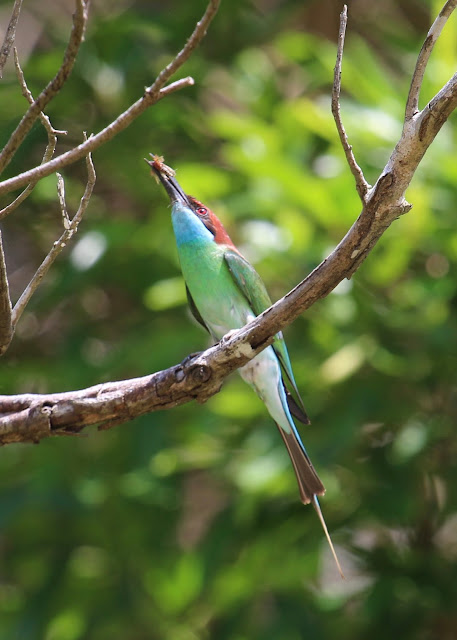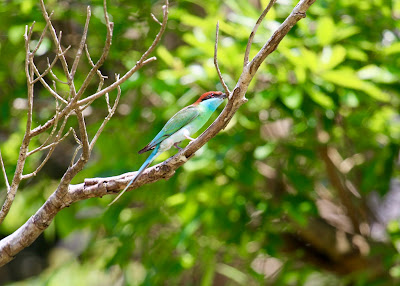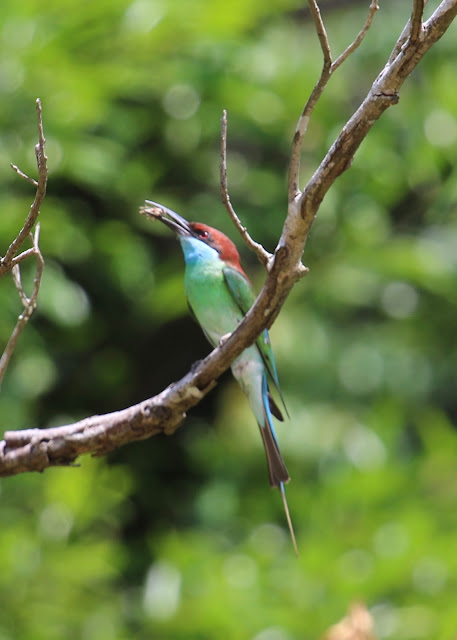There are 10,000 birds in the world and I want to see and photograph them all. It is the very definition of an impossible task. Too little time and too many birds. I need to post a picture daily to finish in my lifetime. Let's see where we get to
Saturday, 20 May 2017
344 : Blue-Throated Bee-Eater
Blue-Throated Bee-Eater - Merops viridis
I am enjoying tapping up my birds again on this site after a long break. I have a big backlog of beautiful birds to capture. To stick into my online book like so many living stamps. It has been so long since I went to Malaysia (almost a year) that I had forgotten that as well notching up a couple of Hornbill species I added to my stunning collection of Bee-Eaters. Bee-Eaters have a very special place in the Daily Bird as the journey began with a Chestnut Headed Bee-Eater - bird number 1 in 2011 ! These have to be a favorite with all birders. If you are a British birder you are unlikely to see one until you venture over onto the continent where you will bump into our European Bee-Eater. If you make it on safari then a world of African Bee-Eaters opens up - to date I have managed to capture these charming Little Bee-Eaters. Or if you are dyslexic and live in the Gulf like me you can delight in these Little Green Bea-Eaters. My spelling is nothing if not atrocious. In November I am taking Jane to Zambia on a short safari. I know the camp we have chosen is close to a colony of Carmine Bee-Eaters. When I get a photo of one of those I will probably just collapse. They cannot be real but then again before I saw my first Bee-Eater in Italy on honeymoon I wasn't prepared for just how beautiful individual birds could be.
I was watching the BBC's Mexico series tonight and it looks like we will have to go to the Yucatan peninsula to see something called an Azure-browed Motmot. They nest inside collapsed limestone lakes and display with beautiful long pennant feathers. Their heads are crowned with iridescent aqua feathers set off with chocolate brown coloring. Not unlike our friend above. Mexico - I didn't know they had Howler Monkeys, Jaguars, Bears and Motmots - good old BBC.
Back to Bee-eaters. What is clear is that this whole family of Old World birds is a stunning jewelry box full of very special creatures. Treasure birds. When you are heading off somewhere new there is always the excitement of buying a new book - say Birds of South-East Asia or Birds of Southern Africa. for some taxanomic reason around the middle of each book there will be a collection of 4 or 5 plates gathered on which are all the Trogons, Parrots, Green Pigeons and Bee-Eaters. There is some science in the order of bird books which I cannot recall but it does seem as if all of the most special looking birds crowd together on just 4 or 5 pages somewhere near the middle - or perhaps its something to do with printing ? So all of my bird books start with white, brown, grey, more brown, fawn, tawny, black birds and then oh wow ! - as if a bunch of primary school children with a new set of felt tip pens has been let loose the plate for the Bee-Eaters is dropped in to brighten up a rainy morning at school ... or a dark evening dreaming about a birding journey. No birder can ever tire of a Bee-Eater.
So this fellow was a compassionate gift from the National Park after I had managed to stumble my way through dense rainforest for 4 hours without getting a decent shot of anything. I did see elephant dung which was exciting but very old - but great to know that the pygmy elephants were there.
The forest knew that I had earned something decent other than my lunch and as we rounded a corner of the river both Matte and I started beaming and the instructions were given to cut the engine. All was quiet and we drifted past the perch and I started snapping away - with far more success than I had mustered during the rest of the morning. The sun was in the right place - I got a catch-light in the bird's eye. The bird was doing something interesting. It had caught a Bee and was rubbing out the sting on its perch. We drifted past - and then reversed back and I was able to check the shots and take another pass before the bird flew off. I have a bad habit of watching a bird fly away to see where it goes rather than trying for flight shots so most of my pictures are on perches !
All was now very good with the world and with me. The rainforest and the river with its towering trees was now a friend.
I cannot remember the name of this individual tree species but some were in flower and tiny petals would float down carpeting the trails and water. They must have been 60 m tall some of them. They reminded me of the trees in Loth Lorien. Shining white bark and these huge sprays of hundreds of thousands of tiny flowers.
I also knew I had a cracking guide who by the end of my short stay would turn out to be one of those guys who gives so much in 3 days that you are just sad to say goodbye. This guy loved the Park and knew every tree, bird, mammal and reptile. He had seen a tiger once swimming across a small tributary when out in a boat with his father. Once in a lifetime - and he lives on the edge of the park. There are perhaps 10 tigers left in the forest today. He was also active with local conservation - if only more people in Asia could be in love with the forest and its birds. He also had much keener eyes than me, a smart phone with tape lures (recorded song) for every species we wanted to see (although none seemed to work for us when we tried - wrong season) and a good sense of humor. I asked him what were likely to see one day and replied "with some luck not too many Homo sapiens".
I think this is his best smile for the paying birder look. He hated snakes and thats a good story for another blog. I look forward to telling that one. I was better with the snake.
So by lunchtime on the first day I had decided that walking was bad and that boats were good. We took to Matte's car one afternoon for a bit a road trip out of the National Park which is another heart-breaking story. I'll leave it there for now with the Blue Throated Bee-Eater. Thats 5 species out of the 25 or so species worldwide so in Bee-Eater terms I am 20 % of the way there. In general terms I am just scraping 3 % of the worlds birds logged on this site. Who is in any rush though. I didn't know until this evening what a Motmot looked like and I haven't had time to check the spelling yet.
Blue-Throated Bee-Eater, Merops viridis
Taman Negarra National Park, Peninsula Malaysia
4-6 June 2016
Subscribe to:
Post Comments (Atom)







No comments:
Post a Comment